
Delphinium is a genus of about 300 species of annual and perennial flowering plants in the family Ranunculaceae, native throughout the Northern Hemisphere and also on the high mountains of tropical Africa. The genus was erected by Carl Linnaeus.
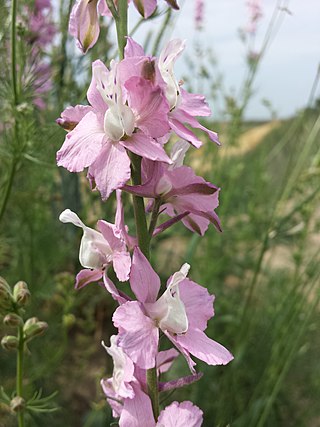
Consolida is a genus of about 40 species of annual flowering plants in the family Ranunculaceae, native to western Europe, the Mediterranean and Asia. Phylogenetic studies show that Consolida is actually an annual clade nested within the genus Delphinium and it has been treated as a synonym of Delphinium in Kew's Plants of the World Online. The name of the genus comes from an archaic use of consolidation, meaning "healing", in reference to the plant's medieval use for healing wounds.
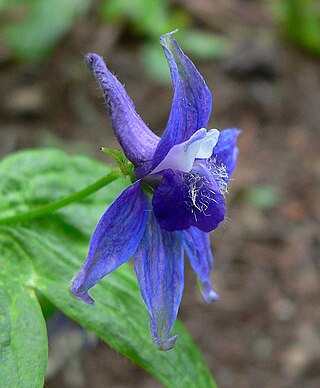
Delphinium bakeri, or Baker's larkspur, is a species of perennial herb in the buttercup family, Ranunculaceae. It is endemic to California in the United States, where it is a federally listed endangered species. It is known in the wild from one remaining occurrence near Salmon Creek in Sonoma County, where only seven plants remained as of March 2006.

Delphinium luteum, known by the common name yellow larkspur, is a species of small perennial herb in the buttercup family bearing bright yellow cornucopia-shaped flowers. Endemic to the rocky, foggy hillsides of coastal Sonoma County, California, it is critically endangered, with about 200 individuals believed to be in existence as of 2005.
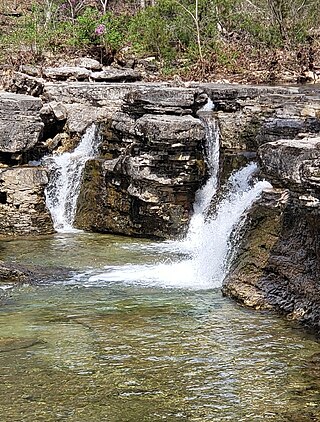
The Hercules Glades Wilderness is a 12,314-acre (50 km2) wilderness area in Taney County in the Ozarks of southwest Missouri. The United States Congress designated it a wilderness in 1976, making it the oldest wilderness area in Missouri. It is one of eight wilderness areas in the Mark Twain National Forest and is within the Ava-Cassville-Willow Springs ranger district, about 10 miles (16 km) northeast of Branson, Missouri. Hercules Glades Wilderness derives its name from the open limestone glades (balds) that dot its landscape. The high points of Coy Bald and Pilot Knob stand 600 feet above Long Creek and offer splendid views of the drainage. Near the middle of the wilderness area is the main set of waterfalls, though Long Creek has several other smaller waterfalls and cascades along its path.
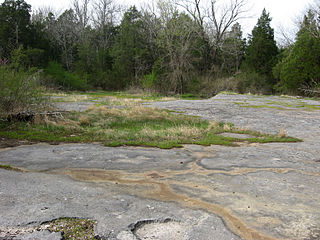
A calcareous glade is a type of ecological community that is found in the central Eastern United States. Calcareous glades occur where bedrock such as limestone occurs near or at the surface, and have very shallow and little soil development. Due to the shallow soil and the extreme conditions created by it, trees are often unable to grow in the glades. This creates a habitat that is usually sunny, dry, and hot. Calcareous glade vegetation is more similar to that of a desert habitat than a grassland, being dominated by small spring annuals with occasional geophytic or succulent perennials.
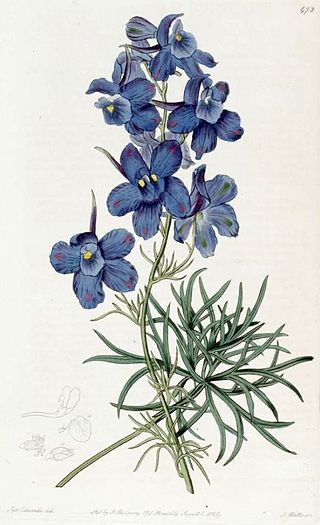
Delphinium grandiflorum is a species of Delphinium known by the common names Siberian larkspur and Chinese Delphinium. It is native to Russia and China. There are several popular cultivars in several colours which are grown as ornamental plants, including 'Blue Butterfly', 'Summer Morning', 'Blue Mirror', and 'Summer Stars'. Like many other larkspurs, this plant is poisonous. It is much shorter and more compact than the more familiar tall D. elatum, with dispersed flowers, rather than single spikes.
Delphinium umbraculorum is a species of larkspur known by the common name umbrella larkspur. However, its epithet does not denote an umbrella. Instead, it describes the habitat of this plant, usually shady and cool places. It is often confused with D. parryii which has similar flowers and D. patens which has similar stems and leaves. It is endemic to California, where it grows in the woodlands of the coastal mountain ranges from Monterey to Ventura Counties. It is a perennial herb producing an erect stem 40 to about 80 centimeters tall. The hairless leaves are located at the base of the plant and along the stem as well. The inflorescence bears several flowers with reflexed dark blue sepals and a spur over a centimeter long. The fruit is between 1 and 2 centimeters long.

Physaria filiformis is a rare species of flowering plant in the family Brassicaceae known by the common names Missouri bladderpod and limestone glade bladderpod. It is native to Missouri and Arkansas in the United States. It was federally listed as an endangered species in 1987 and it was downlisted to threatened status in 2003. P. filiformis remains listed as an endangered species at the state level in Missouri.
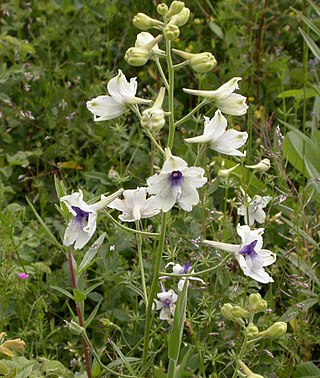
Delphinium pavonaceum is a species of flowering plant in the buttercup family known by the common name peacock larkspur. It is endemic to Oregon in the United States, where it is limited to the Willamette Valley.
Delphinium viridescens is a species of flowering plant in the buttercup family known by the common name Wenatchee larkspur. It is endemic to central Washington state in the United States, where it occurs in the Wenatchee Mountains in Chelan and Kittitas Counties.

Delphinium tricorne, known by the common names dwarf larkspur or spring larkspur, is a species of flowering plant in the Ranunculaceae (buttercup) family. It is native to the central and eastern United States, where it is the most common Delphinium found.

Delphinium barbeyi is a species of flowering plant in the buttercup family known by the common names subalpine larkspur, tall larkspur, and Barbey's larkspur. It is native to the interior western United States, where it occurs in the states of Arizona, Colorado, New Mexico, Utah, and Wyoming.

Delphinium exaltatum, known by the common name tall larkspur, is a species of flowering plant in the genus Delphinium, part of the buttercup family. Other Delphinium species are also commonly known as tall larkspur, such as Delphinium barbeyi. D. exaltatum is native to the central and eastern United States, where it can be found in Kentucky, Maine, Ohio, Pennsylvania, Maryland, West Virginia, Virginia, North Carolina, Alabama, Tennessee, and Missouri.

Delphinium elatum is a species of flowering plant in the buttercup family Ranunculaceae, known by the common name alpine delphinium, guardian lavender, or candle larkspur. It is native to temperate Asia and Europe, it is an erect herbaceous perennial growing to 1.8 m (5.9 ft), with deeply divided leaves. It produces spikes of blue or purple flowers in summer.

Delphinium peregrinum, also commonly known as violet larkspur, is a Eurasian flowering plant, belonging to the genus Delphinium, endemic to Turkey, the Eastern Mediterranean and Western Irano-Turanian region, bearing an erect, annual stem with glabrous compound leaves and reaching a height of 27–35 cm. The plant, which blossoms between April and August, bears five colorful sepals (calyx), petaloid, the posterior sepal spurred, the two lateral sepals and the two lower sepals without spurs; while the anterior sepals can either be fused or separated. The inflorescence (corollas) are sparsely arranged, irregular, and are borne on long pedicels subtended by bracts.

Delphinium geyeri is a species of plant in the Ranunculaceae family that is often called by the common names plains larkspur and foothills larkspur. It is infamous for causing the deaths of cattle grazing in the spring because it is especially poisonous before it flowers and so it is also called poisonweed by ranchers. It is a medium to tall plant that has very striking blue flowers and is occasionally grown in native plant gardens for this reason. It grows mainly in Wyoming with large population in northern Colorado, northeastern Utah, and parts of Nebraska.

Delphinium glareosum is a species of larkspur which grows in Oregon, Washington, and British Columbia. It is in the Ranunculaceae. These plants favor rocky slopes. They flower in summer. Like all members of the genus Delphinium, rockslide larkspur is poisonous.

















